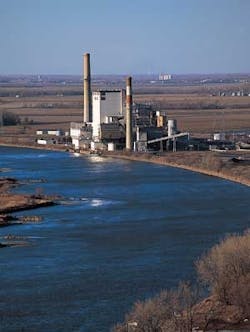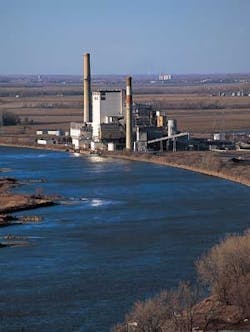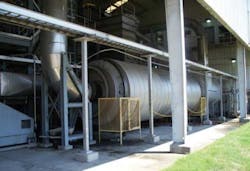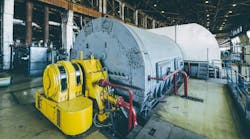• Demand for energy has the North American water and wastewater market for the power industry in growth mode over the next few years – which means a steamy future for niche players, says Frost & Sullivan.
The North American water treatment market in the power industry is in a growth stage, driven mainly byOne of the lowest-cost generators of electricity in the nation, MidAmerican’s generation portfolio includes four plants south of Sioux City, Iowa, including the Neal Generating Station pictured here.
A Competitive Market
This market is extremely competitive and there are many niche participants offering similar services as that of the market leaders. Price is one of the major factors in this market. The boiler water treatment market is highly fragmented because of the large number of companies operating in this segment. Ion exchange, the old and reliable technology that has been extensively used for boiler water treatment, is slowly being displaced by electro-deionization.
Membrane systems continue to dominate the market by offering superior technology in reverse osmosis (RO) and ultrafiltration (UF), which are very important in boiler feed water treatment and condensate polishing. With increasingly stringent surface discharge standards and growing concerns over the depleting fresh water resources, wastewater treatment (especially wastewater reuse and recycling) is gaining momentum. Advanced technologies such as zero liquid discharge (ZLD) and flue gas desulfurization (FGD) blowdown treatment devices are the mainstay in the wastewater treatment segment.
Production of energy is dependent on the availability of water. An indispensable resource for electricity production is fresh water, which is required for various purposes such as high-purity steam, condensate cooling, and other minor applications such as wash water. If there’s an increase in energy demand with a corresponding increase in the requirement of water, then there will be stringent requirement of industrial wastewater discharge. With depleting freshwater resources, power-generating units are likely to implement ZLD technology to save water for long-term requirements. Still, the net water requirement of a power plant depends on the fuel source – be it fossil, nuclear, hydroelectric, or wind.
Areas of Application
Boiler Feed Water: High-pressure boiler feed requires high-quality water. Scale formation and water hardness are the major reasons for poor boiler performance. Water hardness caused by the carbonates of calcium and magnesium is mainly responsible for scale formation in a boiler. Besides, silica and iron are also likely to cause scales that lower the heat transfer rate in a boiler. The impurities in water such as total dissolved solids (TDS) or suspended solids are usually removed through various pretreatment methods. These methods depend on the source of water – surface water, groundwater, re-circulated condensate water, or recycled water. Typically, the power industry requires water quality of less than 10 megaohm and silica content of less than 100 parts per billion (ppb).
Cooling Water: Thermoelectric power plants usually derive energy from heat-generating fuels such as nuclear fuel, coal, oil, natural gas, municipal solid waste, wastewater biogas or biosolids, or other refuse-derived fuel. The heat generated from these fuels produces steam in a boiler, which operates on a turbine and is condensed back to water. Turbine converts the kinetic energy of a moving fluid, steam in this case, to mechanical energy. With a series of blades against which fluids are forced, the shaft of rotating turbines, on which the blades are mounted, is connected to the generator that produces electricity. In general, cooling systems remove excess heat from heat sources. By acting as a heat exchanger, a cooling tower drives ambient air through falling water, which causes some of the warmed water to evaporate, thereby dissipating heat and providing cooling. In a re-circulating cooling system, cooling water is continuously recycled from the condenser, where it absorbs heat by cooling and condensing steam, to the tower where it rejects heat to the atmosphere before returning to the condenser. There are two types of re-circulation systems – wet cooling towers and dry cooling towers. In a wet cooling tower, some water is lost to evaporation and the remaining water is removed from the re-circulating system as a blowdown stream to control the build-up of suspended and dissolved solids that accumulate due to addition of water treatment chemicals. To replace the lost water, makeup water is usually withdrawn from surface water bodies. The volume of makeup water is several times smaller than the volume needed to operate a once-through system.
Wastewater: Typically, wastewater in a power plant constitutes water from cooling water systems and boiler blowdown. With increasingly stringent discharge requirements by the Environmental Protection Agency (EPA), the power industry is focusing on treating wastewater and reusing it for cooling water makeup and as boiler feed water. This reduces water intake for boiler and cooling tower operations. It becomes especially important in the case of once-through cooling systems, which consume very large volumes of water. Wet scrubbing, which is used to remove sulfur dioxide through an FGD process, results in highly corrosive wastewater that’s proving to be a challenge for plant utilities.
Market Drivers
- Growing population and energy demand drives the market
- Requirement of water for the functioning of a plant favors the market
- Need to reuse wastewater enhances equipment sales
- Installation of new plants and old plant retrofits aid growth
Market Size
Table 1 lists out the market size of each of the segments in 2008.
Competition
Table 2 provides the rankings of the major market participants in North America Ion Exchange Systems Market in the power industry in 2008.
Other companies active in this market include Degremont Technologies-Anderson, Tenergy Christ Water LLC, Integrated Separation Solutions LLC, and GE Water & Process Technologies.
Conclusion
The North American water treatment market in the power industry expects continued growth. In the future, power plants are likely to convert to combined cycle plants, coal gasification units, gas-fired plants, and nuclear and renewable energy sources plant such as wind. However, during the short term, coal-fired plants are expected to dominate the market as they are economically viable.
About the Author: Shilpa Tiku is a research analyst with Palo Alto, CA-based global growth consulting company Frost & Sullivan’s North American Environmental & Building Technologies practice. Since August 2003, she has analyzed trends in U.S. water and wastewater treatment, waste management, and air pollution control markets. Contact: [email protected] or www.frost.com




